Let’s begin with a serene sunset over Royal Albert Dock, as seen the other evening as I was walking along the university campus to Gallions Reach DLR Station:

Earlier, the day had been warm and sunny with rowers out on the dock enjoying Canary Wharf as the backdrop:


And the evening view from Gallions Reach DLR towards Canary Wharf, with the new Porsche Showroom glowing in the darkness (Oh how the wilderness of far East London has come up!), for a change gave no sign of any threatening weather on the way:

…and indeed today has been breezy but nothing worse than that, and the somewhat broken cloud towards evening suggested that a good sunset might be on the cards so I jumped onto the bike (now named ‘Monty’ according to my daughter) and headed off into the Myland fields. Things did indeed look promising:

Sitting on my little folding stool and watching things develop, the thick rows of cumulus mediocris blowing out of the west suddenly thinned to reveal an extraordinary display of golden cirrocumulus high above the darker cloud streets:

As the lower clouds moved off east, the sky above took on an appearance even more spectacular than a display of northern lights (which I’ve seen a couple of times in the far north of Scotland), with rose-gold clouds spreading across the entire bowl of a dark blue sky:


Then just as abruptly, banks of low cumulus blew in over the western horizon and it felt as though the night switch had been thrown:

Despite this, the golden glow from the remaining narrow window of sunset was bathing the field (and Monty) in a rose-gold glow:

Turning back to the sunset, I was surprised to see that the dark clouds had again dispersed somewhat and that the western sky was again a mix of dark blue, gold and flame-red:


This turned the whole darkening sky the sort of orange-pink that had caused such a stir the other day during the visit of Hurricane Ophelia, but here it was going largely un-remarked, and it was a glorious feeling to be standing in the field bathed in this strange luminescent glow. The moon had appeared above the horizon too, adding to the glow as it dodged in an out from behind the racing clouds:
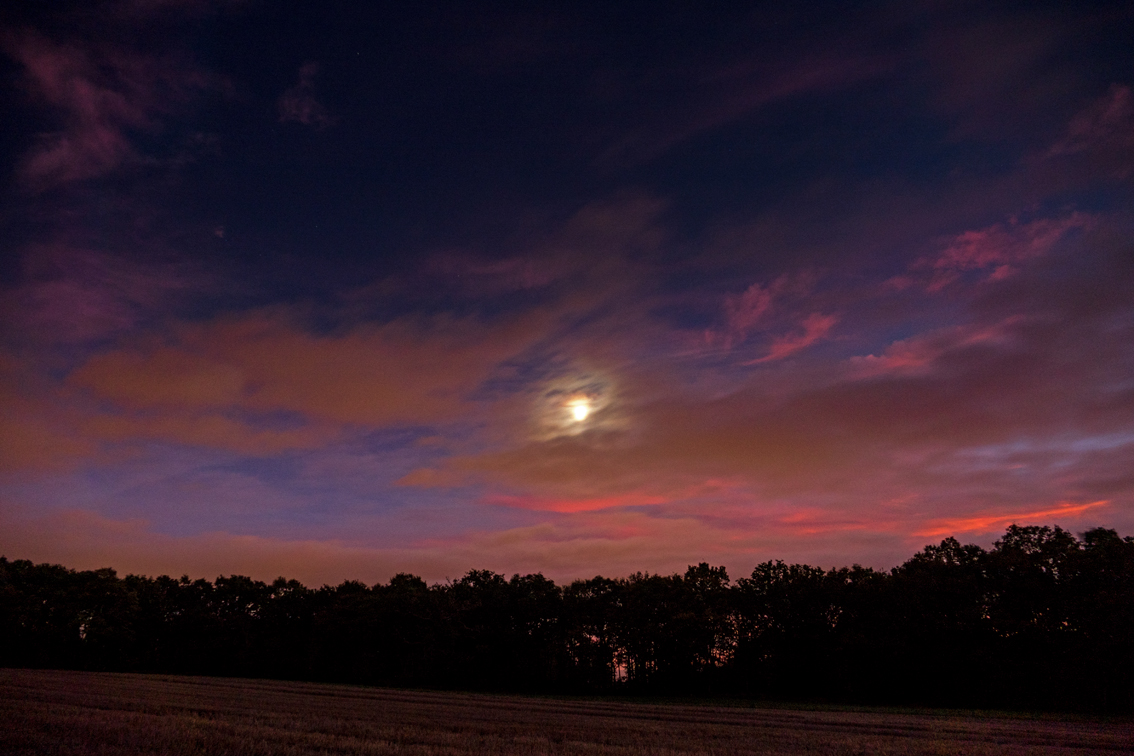

Finally, however, the light began to fade completely, though it still left a golden-red glow in the west:

I was tempted to stay and see just how long it would linger, but the wind was picking up even more, it was now in effect pitch dark, and although Denis has an excellent front light I didn’t fancy pitching headlong into one of the deep drainage ditches that surround the fields so it seemed like a good moment to head home…. ….to find that England has finally won the World Cup !! Huge congratulations to the U17s, fighting back from 2-0 down to win 5-2 !! Spirit of 1966 🙂 (which I remember – in grainy black and white) 🙂
Category: Uncategorized
What the commuter saw: 25th October 2017 – sunshine and sunsets
After a few rather dismal days, the journey from Colchester to London once more enjoyed blue skies with somewhat raggedy cumulus, from the start of the journey over the Colne Valley:

Then past the two poplars west of Marks Tey:
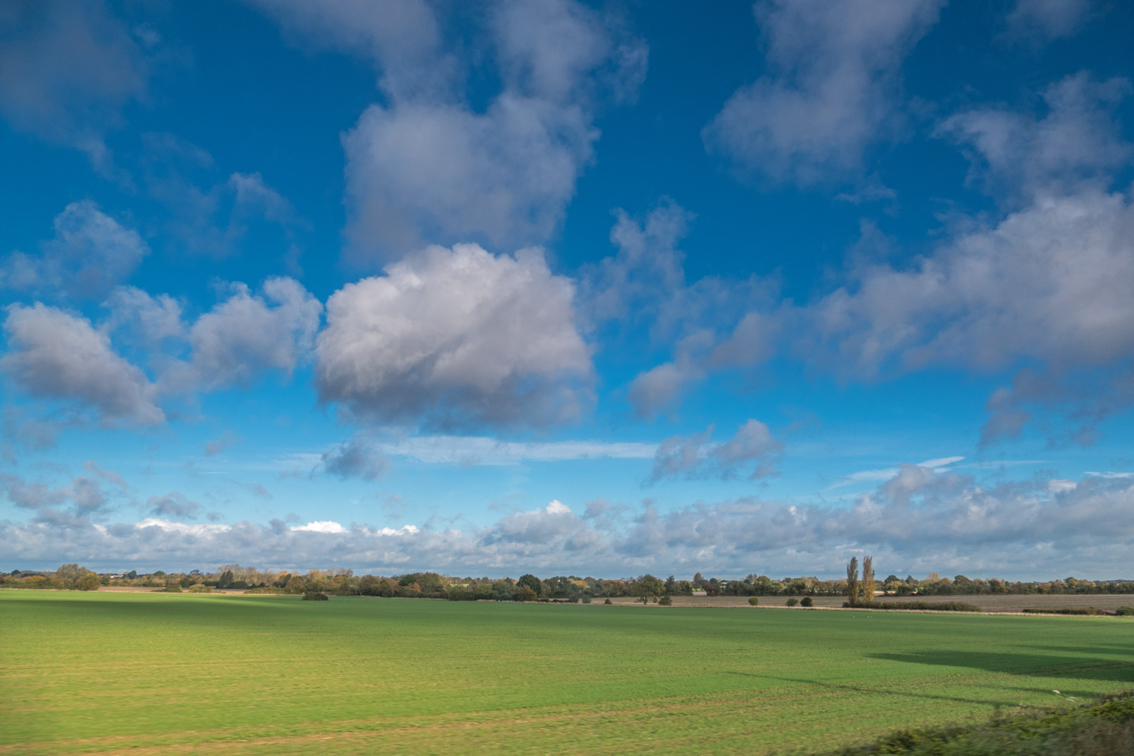
Then almost (but not quite) forming ‘cloud streets’ of cumulus mediocris west of Witham:


Towards the end of the day, on walking back to our office from the lab to obtain a copy of material for our MRes student, I found the Albert Dock bathed in a gloriously serene sunset. A quickly grabbed panorama was followed by a hasty dash back to the office and even more hasty photocopying while through the office window I watched anxiously as the sunset reach its peak:
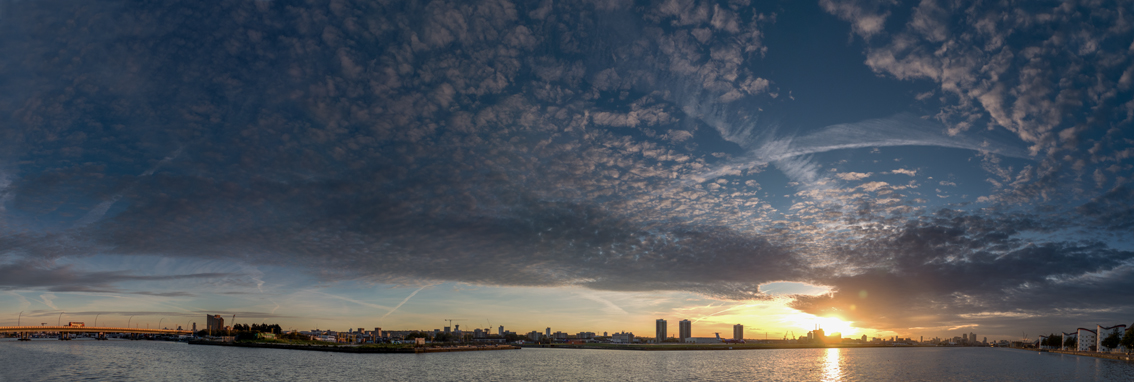
Having completed the photocopying I dashed out to the dockside, papers flying, and fortunately just caught the fiery burst as the sun finally slid below the horizon directly over London City Airport:




It was only while putting the camera away that I realised there were groups of students scattered all along the dockside – many of them 1st Years, I guess – snapping away at the sunset on their smartphones to capture the amazing sights to be seen from their university campus, and presumably then sending these to their friends and relatives all around the world. There was a sort of hushed silence all along the dock, and it was really rather sweet that they seemed so awestruck by the scene, rather than noisily capturing selfies… 🙂
Red Sun, Rain Storms and Restoring Bogs – Cumbria, October 2017
Well, the sky has been something of a talking point over the past week, what with Storm Ophelia, other-worldly skies worthy of Blade Runner, then Storm Brian. Unbelievably, given that I lug my camera round everywhere with me in case of interesting skies, the ‘Day of the Red Sun and Orange Skies’ was the one day of the year when I forgot to grab the camera as I left home for work. Consequently while everyone else in the south of Britain was snapping away with their smartphones and talking nervously about ‘the end of days’, I was kicking myself all round the university campus. Ah well…
The next day dawned bright and sunny, of course, so my hopes that the Sahara dust and Portuguese smoke would continue to hang over us were largely blown away along with the sand and smoke. I say ‘largely’ because in fact a close look at the hazy banks of stratus over the poplar field west of Chelmsford revealed a faint rosy tinge:

This tint remained as far west as the Lone Oak east of Shenfield:
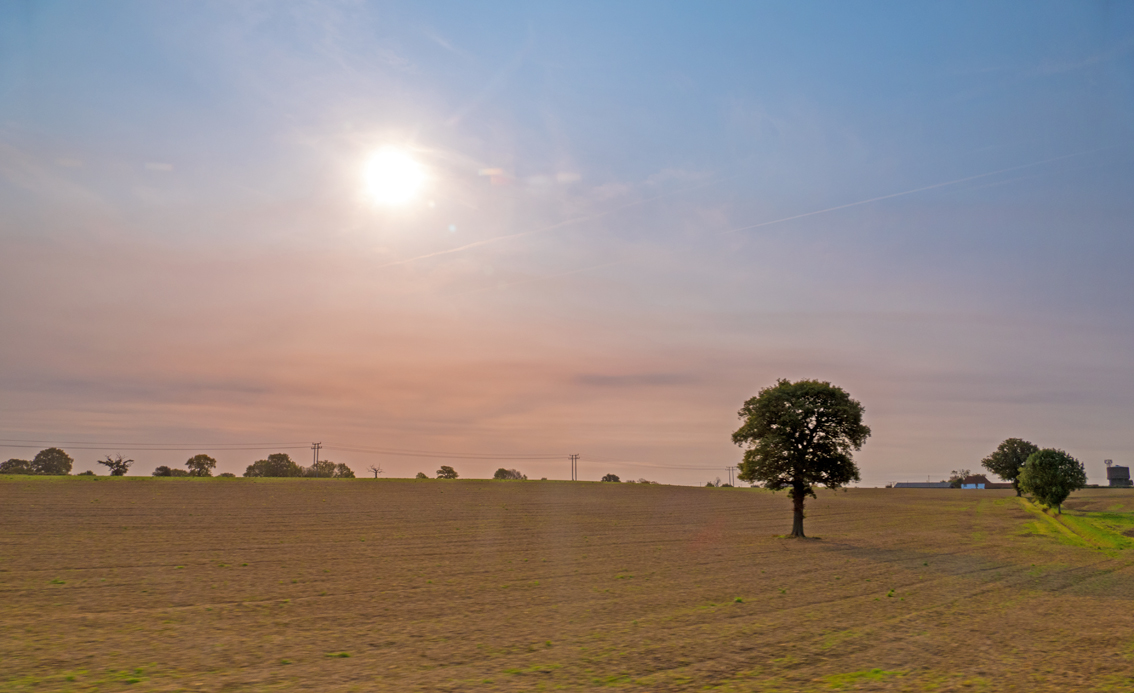
…but by the time I arrived at UEL’s Campus at the Royal Docks there was just the barest hint of rose in the banks of altocumulus and alstostratus which covered the sky and partially masked the sun:

By lunchtime all trace of ‘Hurricane’ Ophelia’s Sahara dust had gone, swept away to the north but leaving a fairly confused sky in its wake:


After a couple of days to gather our collective breath, storm warnings were again being posted, this time for Storm Brian. Reading these dire warnings, I feel that this is not ideal because I am due to be visiting a peatland restoration site in northern Cumbria with folk from Micropropagation Services, and indeed the sky looks increasingly ominous as I head north out of Euston towards Carlisle courtesy of Virgin West Coast:


By the time my train approaches the Lake District, the familiar mound of Hutton Roof Crags and its extraordinary limestone pavement is looking decidedly damp, while the fields in the foreground have already surrendered to the flood:

South Lakeland (where I started my career) is hunkering down beneath drenching bands of rain:


North of Kendal and heading towards the stunning River Lune gap as it wends its way between the hills of the Lake District and those of the Howgills, I am struck by the contrast of the scene at Fiddler Gill in comparison with the last time I crossed Flodder Beck:

This was only back in August:
This is not an evening to be wandering ‘lonely as a cloud’ in Lakeland; even the clouds are not wandering lonely this evening:

After the Howgills we emerge onto the long climb up to Shap Summit, and whereas on a good day there are wonderful views west all the way to the black rugged Borrowdale volcanics of the Langdale Pikes in the heart of the Lakes, this evening the heart of the Lake District is invisible, obliterated by the advancing weather fronts of Storm Brian as my train arrows north into the gathering dusk:


It’s all looking a bit grim for the site visit tomorrow…
Things don’t look enormously promising the following morning, with roiling banks of stratocumulus by the time we arrive at the site (Bolton Fell Moss – scene of an enormous amount of work for me and my colleague Jack a few short years ago, involving, amongst other things, purchase of a huge pizza oven and a criminal fleeing to South America with a suitcase full of money – but that story is for another time):
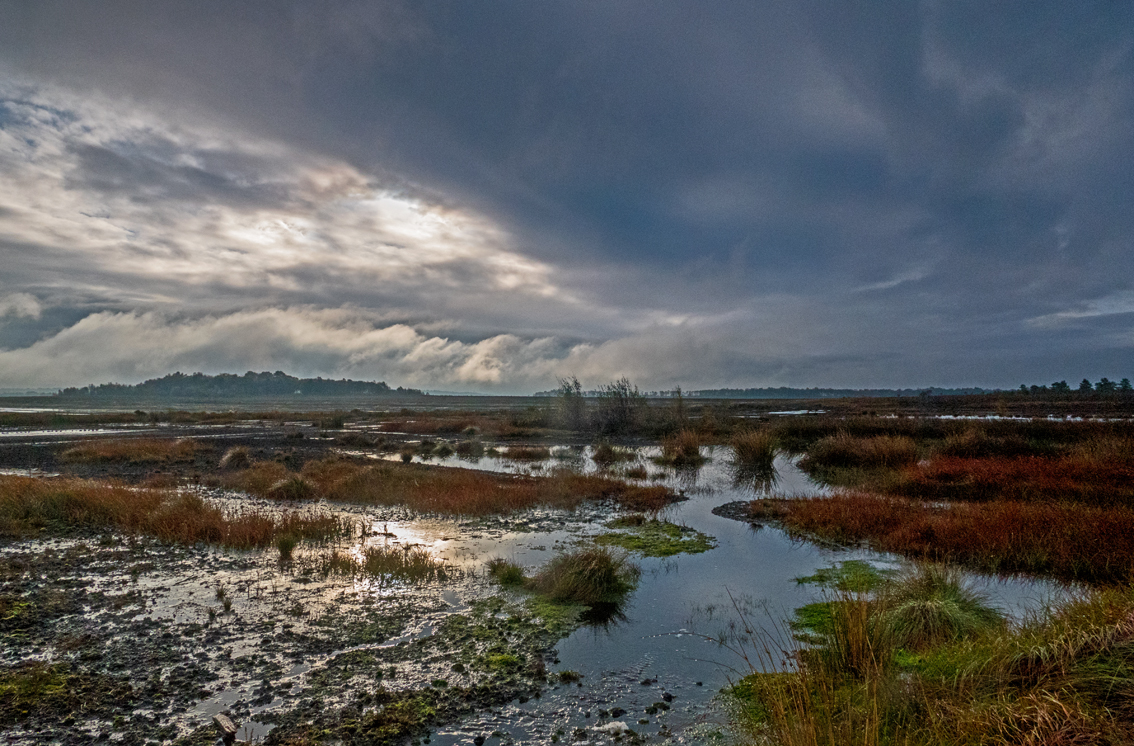

To our relief, however, after wandering round the horizon in distinctly threatening manner, these huge clouds appear to lose interest in threats and menaces, abruptly transforming themselves first into a sort of ground-hugging but rather gentle bank of cumulus fog which then drifts apart and fragments like pieces of a damp paper napkin to reveal beautifully clear blue sky:

Within half an hour the entire sky has become an orderly series of ‘cloud streets’ as ribbons of cumulus mediocris are shaped and aligned by the steady wind. The last thing I had expected to find on the journey north was that by the end of the site visit I would be sunburned…!

Fieldwork, eh? 🙂
What the Commuter Saw: 25-29th September 2017
The end of September brought a succession of weather fronts sweeping across London and Essex. When it wasn’t raining it was blazing sunshine (though mostly it was preparing to rain, already pouring down, or just easing off) so quick-change waterproof jackets or umbrellas combined with lightweight summer clothing were order of the day. Still, it made for interesting skies. The 25th began calmly enough, albeit with a complete layer of high thin altostratus cloud over the Colne Valley:

By the time we were leaving Chelmsford and gazing out towards Galleywood, the cloud was thickening noticeably:

Coming into Ingatestone the cloud layer was starting to boil into something quite ominous:

A bank of stratocumulus began to drift in beneath the altostratus as we passed the hills surrounding Billericay, threatening rain (two or more layers of cloud is never a good sign):

Sure enough, by the time I arrived at work there were heavy rain-showers sweeping up the Royal Docks.
The next day started with blue sky and billowing cumulus all the way past Witham:



But by Chelmsford these cumulus clouds were building up into threatening towers of cumulus congestus mixed with a broken layer of stratocumulus castellanus, once again threatening rain-showers…



…until by the Lone Oak of Shenfield the first of these was sweeping in from the west:
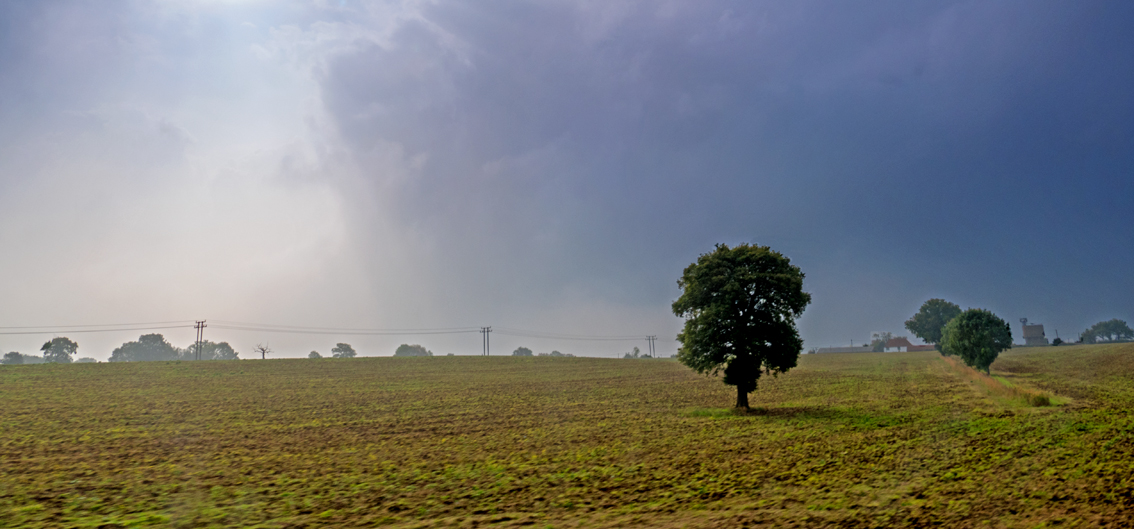
Arriving at the Docklands Campus of UEL, the Royal Albert Dock was ringed by a series of drenching rain-showers while itself being bathed in bright sunshine:

The next journey with Abellio Greater Anglia was on 28th, and it again started with banks of stratocumulus piling up over the two poplars west of Marks Tey:

Then things cleared as we approached Chelmsford, but the long ‘mares’ tails’ of high cirrus scratching their way across the blue sky above the white billowing banks of cumulus presaged the arrival of Hurricane Irma (or at least her tail end) after her long journey across the Atlantic:

A thick bank of cumulus congestus rolled by as we left Chelmsford…

…but after that passed, the sky remained streaked with long ribbons of cirrus uncinus, promising strong winds in a day or so.
The evening journey was provided with a stunning backdrop of cirrostratus fibratus, lit by the setting sun, firstly over New Hall School east of Chelmsford, then across the fields to Hanson Aggregates:


The sky over the fields west of Witham was darkening but no less spectacular:


Then as we crossed the Colne Valley approaching Colchester it was clear that the sunset was due west of us and therefore possibly offered views along Colne Meadows:

Consequently I hared off down the road from the station to the road bridge over the Colne, just in time to catch the last of the sunset (as usual, joined by several people on the footpath who had taken out their smartphones):

A last flash of salmon pink, and the sunset was gone:

Sure enough, the next day brought driving rain with thick swirling blankets of nimbostratus rolling across the Essex countryside:


Welcome to autumn…!
(and do think about my Etsy store if you are short of ideas for winter/Christmas greetings 🙂 )
For those of you wondering about my blancmange blanket bog (see Peak District blog), you can see it on BogFest’s website along with many other excellent presentations, although mine specifically can be downloaded here (and I’m planning to put an extended version on the SRI’s blog page).
New cards and original artworks in store
I’ve just been adding to the stock of original artworks and cards in my Etsy store (here’s a few examples):
https://www.etsy.com/uk/shop/RichardLindsayArts
Cards of landscapes and sunsets coming soon…
Not long to Christmas…!
🙂
Richard.
Peak District to East Anglia – what the commuter saw
I’m just back from the utterly brilliant BogFest (yes, BogFest is a thing), of which undoubtedly more shortly – probably exploring my blancmange peat bog amongst other things. Just for now, however, I’ll explore the journey home from the Peak District and the evening twilight of home.
The morning of Saturday 23rd September started rather overcast and grey – which was probably a good thing for those taking part in the BogFest Fell Race that morning – but by the time I took my leave after talking about a citizen science peatland monitoring programme and stood waiting on the station platform at Edale, there were occasional patches of sunlight rippling across the fell sides:


As the train headed towards Sheffield these patches looked more and more enticing so I decided to hop off at Hathersage and re-visit the scenery around St Michael and All Angels’ Church, which formed the backdrop for a 1st October 2015 Facebook blog of bucolic photographs.
In the end the promised dappled sunlight faded shyly away behind yet more grey stratocumulus, but as I was photographing the cows and the far valley side I became aware that there was a Saturday afternoon cricket match going on down in the meadow at the bottom of the valley, rain not yet having stopped play:


The wall of the churchyard was heaped with ivy (Hedera helix) in flower. It is one of the few species to provide nectar at this time of year, and insect life was making the most of it:




While the graveyard of the church must be one of the most serene places in Britain to be be laid to rest, the village of Hathersage itself has some hidden delights, including a secret stream which gurgles through the centre of the village:

The journey south via Sheffield and London raced through a succession of weather patterns and a countryside which had recently been put to the plough and harrow:

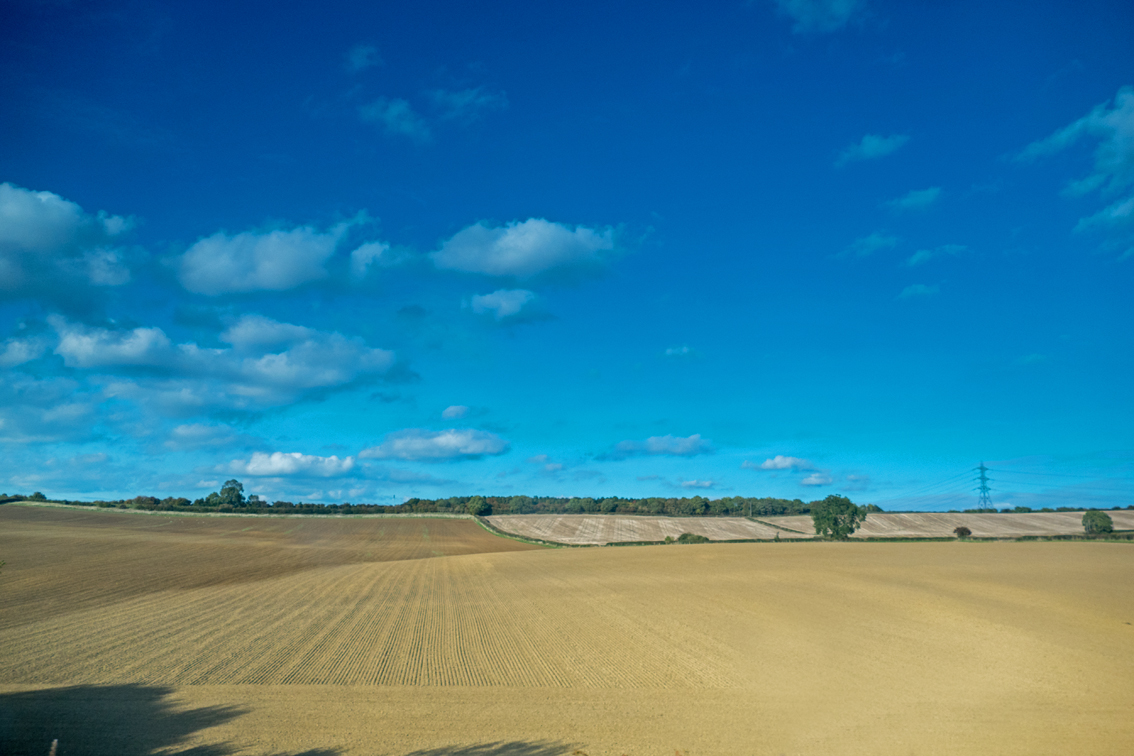

By the time I’d passed from St Pancras to Liverpool Street and headed north-east towards Colchester, dusk was cloaking the landscape in broken stratocumulus. The occasional light, such as that from New Hall School east of Chelmsford, shone out into the gathering darkness:



The following evening I headed out into the Myland fields as I’d not been there for a while. Other than being taken for a dog called ‘Ginger’ at one point, the evening was zen-like in its calmness, and the sun slowly faded into the cloudbank to the west – but then gave a blaze of glory before sliding into the ever-darker twilight of the bats, which were feeding busily for their winter hibernation:


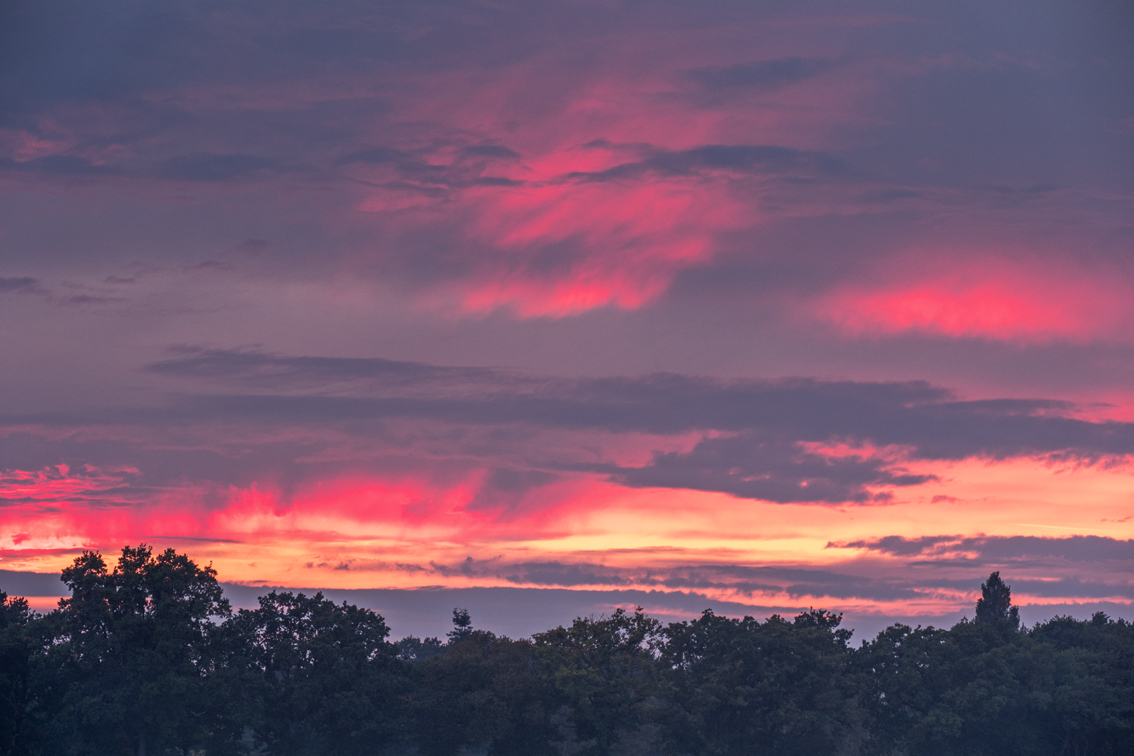



Next up, probably – the blancmange blanket bog…
What the commuter saw : 11-13th September 2017
The weather has continued to be dominated by the cumulonimbus capillatus, and their associated torrential downpours, which characterised my previous post: Colchester landscapes – “the Gates of Hell”. Bright sunshine, albeit accompanied by a cold wind, is abruptly switched off and the heavens open. On Monday I was examining a PhD at UCL on Gower Street, London, and in the course of an afternoon’s examination the view from the window must have been blotted out by monsoon rains at least five times. The journey home to Colchester courtesy of Abellio Greater Anglia offered some fairly spectacular cloud formations – most threatening or actually offering torrential rain. This was some towering cumulus congestus to the north shortly after leaving Shenfield:

The view west towards Billericay produced some spectacularly confused but glorious evening skies:



As we left Chelmsford heading east, the skies over New Hall School looked heavy with rain and were evidently already dumping vast quantities on the land beneath:
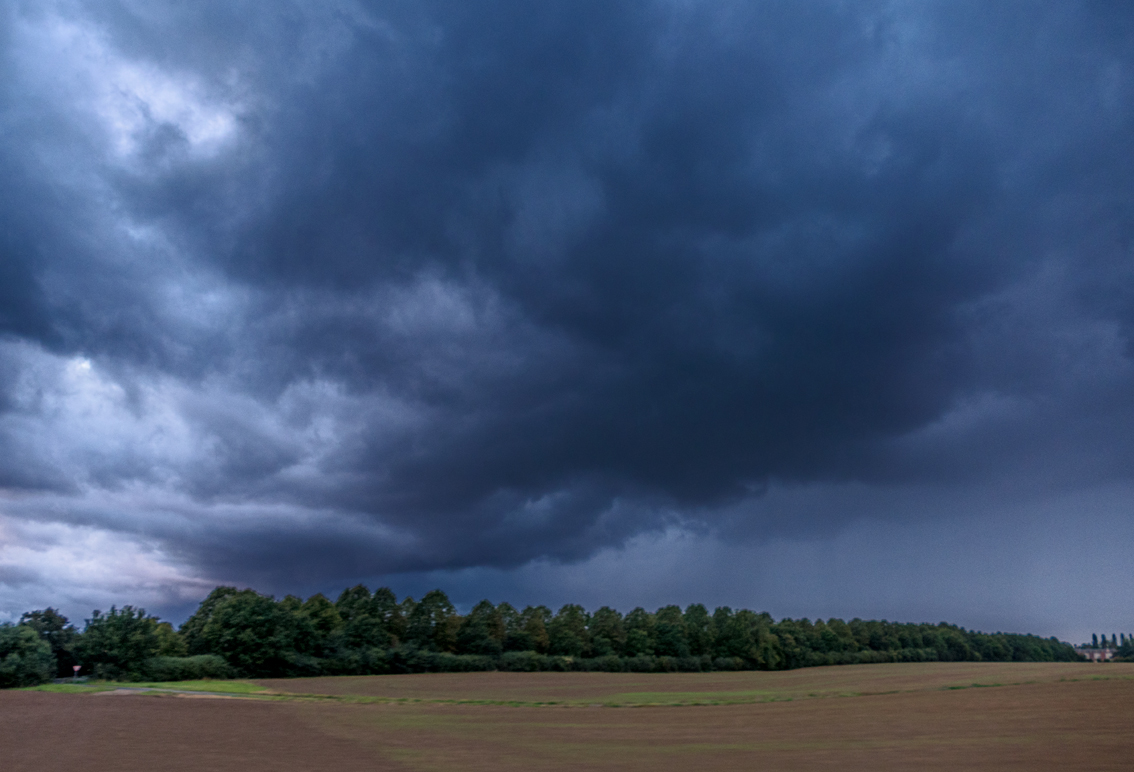
Heading into Kelvedon, the skies to the south were giving birth to more cumulonimbus capillatus anvils:

By the time we were approaching Marks Tey the anvil had grown to immense size:
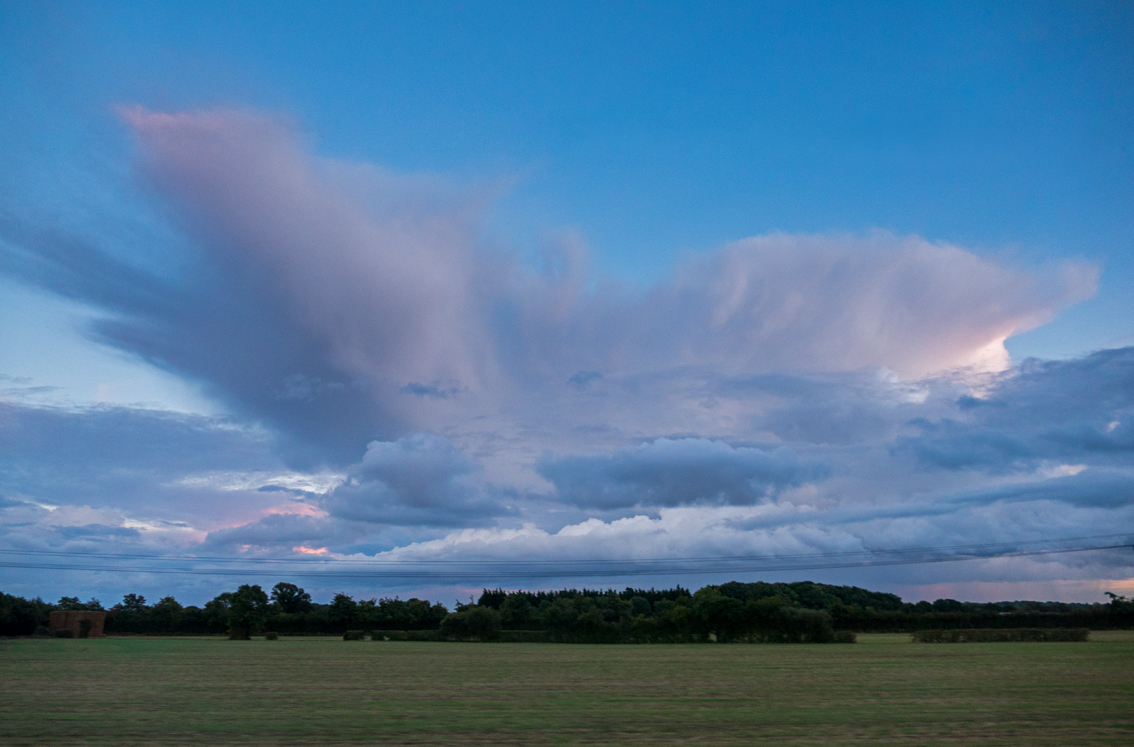
It was also moving steadily towards Colchester, which set me estimating rates of drift, distance between station and home, likelihood of having to swim up the hill homewards like a salmon…

In the event I just made it home before the skies opened once more (though I was in such a sweaty and breathless state that I was not fit to be let loose on polite company) 🙂
Today the weather looked more benign, with what appeared to be fair-weather cumulus populating the sky, albeit accompanied by a very strong wind – so strong that my train from Colchester was cancelled because a tree had fallen on the overhead lines further north towards Norwich:
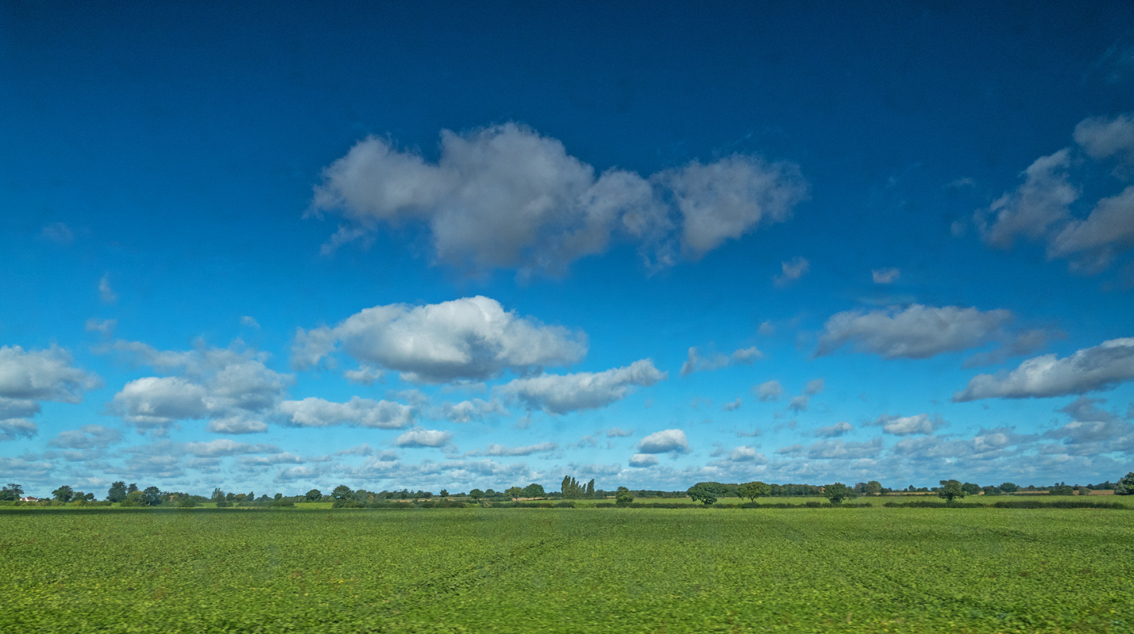
This view of such apparently settled and gentle weather just south of Witham was, however, hugely misleading. After arriving at our Docklands Campus I was welcomed with a mild drenching, then throughout the day it was as though someone was switching the shower full on, then abruptly switching it off again. My colleague, Stuart Connop, described how his wife had been waiting on a station platform the other day and when a torrential downpour occurred, she had seen someone shuffle sideways by about 3 metres and remain totally dry while the rest of the platform had turned into a river – such is the localised nature of a cumulonimbus capillatus rainstorm.
At the end of the day I walked out to the Royal Albert Dock, which forms the southern edge of our Docklands Campus, to see a double rainbow off to the east formed by a combination of the sun setting over Canary Wharf to the west and the light rain overhead which was just enough to need the umbrella while I pulled out my camera:

The planes landing at London City Airport were passing through the rainbow’s arch when coming into land:
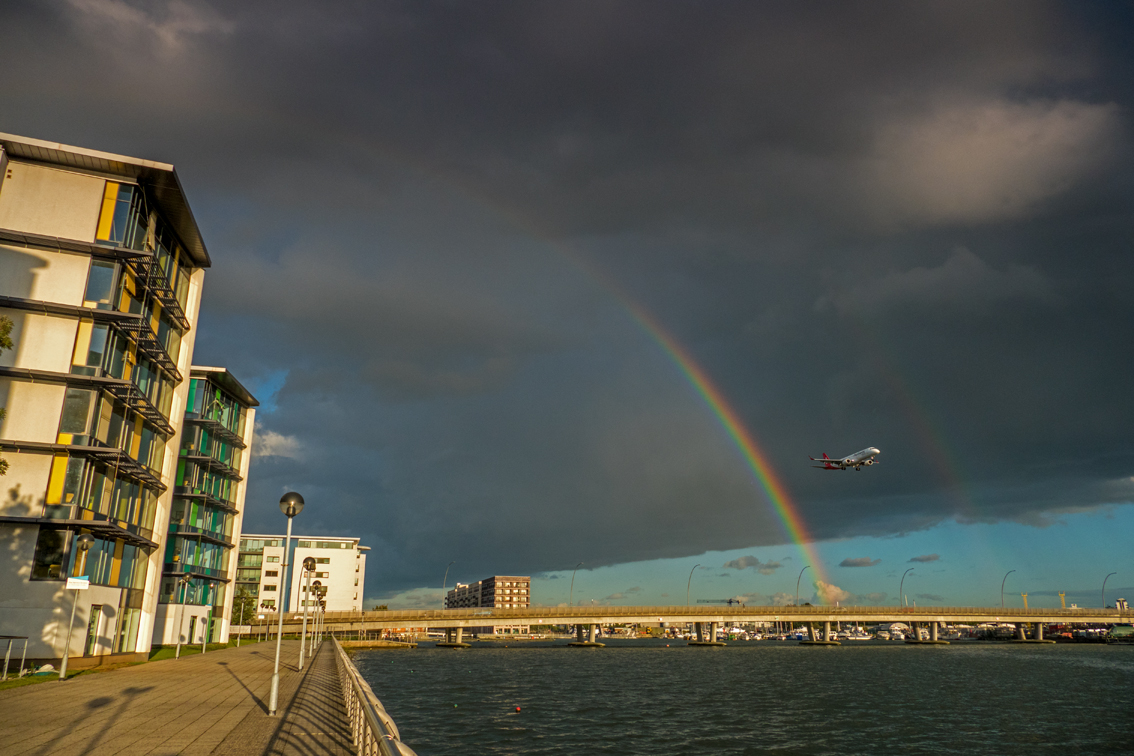
Meanwhile the clouds boiling up around their approach run looked increasingly spectacular……

Looking into the heart of the clouds it was possible to see the roiling air currents, but also the remnants of the rainbow caught like a fly in the web of falling rain:

….although there is something remarkably zen and calming about gazing into the heart of such a cloud:

Clouds – never a dull moment.
Colchester landscapes – “The Gates of Hell”
A day of occasional light showers ended in a blaze of glory over Colne Meadows, with the setting sun being swallowed up by a whole bank of cumulonimbus capillatus anvils which dominated the western sky. I was driving back from B&Q at the time so could do little about this glorious display, but on arriving home I leaped onto my bike and went haring down the hill in the gathering gloom to the Colne Meadows bridge, tripod and new camera strapped to various parts of the bike but convinced I’d missed the whole spectacle.
Arriving breathless but relieved, it was clear that the display had not entirely ended, plus the mist had risen quite suddenly over the meadows to create a rather soft-focus ambience (just how soft focus I was to discover later). Setting up the camera on the tripod I prepared to start capturing a series of stunning images – only to realise that I couldn’t recall how to switch off focus tracking nor manual aperture settings, and in the gathering gloom I couldn’t even see the letters on the various control buttons. The perils of a new camera… After fumbling round frantically for a time – all the while aware that the scene before me was fading – I managed to establish control of the camera and proceeded to rattle off some pictures:


I was doing this from the cycle path which runs alongside the main road leading to Colchester (North) Station, and while I was taking my photographs I was joined by a succession of cyclists and walkers who stopped, took out their smartphones, and proceeded to record the view. Each in turn commented on how amazed they were by the scene unfolding across the meadow, and one commented that it was: “..like looking into the Gates of Hell”. One individual even skidded his car to a halt on the central reservation having just turned off the roundabout, then ran across the road to photograph the scene on the inevitable smartphone before asking: “That is fog, isn’t it? It’s just that the missus wouldn’t believe me.”

Clambering down over a stile and into the meadow itself, I blessed the fact that the new camera offered manual focusing using a focusing ring on the lens barrel because the automatic focusing just couldn’t cope with the combination of gloom and rising mist:

The various numulonimbus capillatus anvils had separated by now, with several heading north but one for some reason heading south:

The last anvil sort of collapsed and lost much of its anvil shape:

The one drifting south was meanwhile joined by a smaller more distant anvil as the mist rose higher and became steadily thicker:

Turning back to the large cloud to the north, I was struck by how much thicker the mist had become in that direction and thus how indistinct the image was becoming:

Then I had a look at the graduated filter on the front of the lens and realised that it was now coated with a thick film of mist droplets – the ultimate soft-focus trick of professional photographers..! Having wiped the filter dry, the scene leaped into much sharper focus…

To the north, across the Colne and up the hill, the lights of Colchester Station and my favourite Platform 3 were forming large halos of light in the mist:
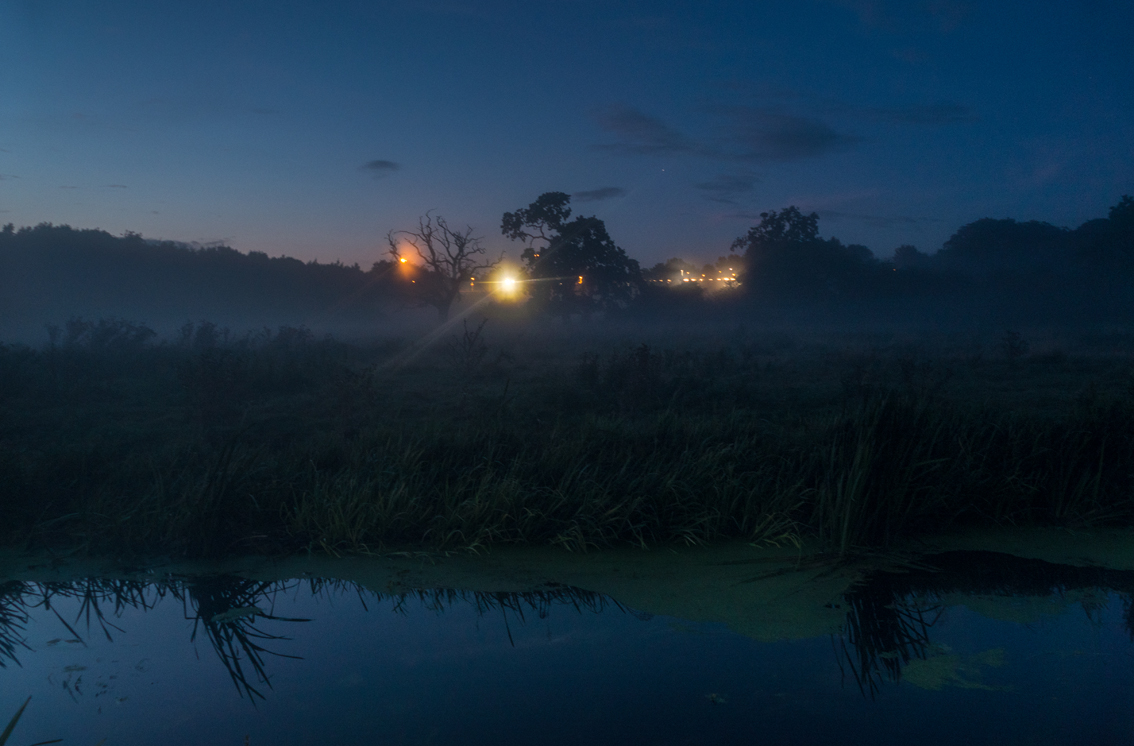
By now it was becoming so dark and so thick with mist that it really was proving very difficult to keep the camera filter clear enough to focus on anything even using manual focus, so I took a couple more of the large shapeless cloud and called it a night, leaving the meadows to the faint cry of a fox roaming somewhere in the gloom:

Hmmmm…. Thick mist, heavy dew fall – does this mean that tomorrow is going to be bright and sunny? I hope so, because I have a peat bog to construct using Angel Delight…. (more on this in due course, hopefully) 🙂
Chichester – planes, predators and paintings : Part 2
Part 2 of this blog is a pretty eclectic affair, beginning and ending with one sort of aerial predator, then involving various other sorts of aerial predator, a great number of cafe racer motorbikes, a view to die for (and I nearly did…), a chipmunk, and Jumbo. To recap from Blog Part 1, we were in Chichester celebrating a special family birthday and had enjoyed, amongst other things, some glorious landscapes and some wonderful aerial displays:


On our second-to-last evening I had spotted something rather exciting soaring round the spire of Chichester Cathedral, so early next morning I headed off to the cathedral grounds, in hope. Having settled myself down with a good view of the spire I then spent 20 minutes watching increasing numbers of people walk past the cathedral on their way to work as the city began to wake up and start the day’s business. Then I spotted what looked like a small lump offsetting the regular symmetry of the stonework pattern high up on the cathedral spire but couldn’t convince myself that it was anything significant, or anything more than a pigeon, even fully zoomed in with my camera. After another ten minutes I was just about to give up (given that we were due to visit the Historic Dockyard in Portsmouth that morning) when suddenly this lump launched itself into the sky, screaming furiously. This was no pigeon:

Various things then happened noisily behind the tower and spire before a shape soared out from behind the spire and shot off directly overhead – an adult peregrine…


This was all I had time for before we headed off for our appointment with the excellent Historic Dockyard and some mast-climbing for daughter. Still, the nautical interlude gave me the opportunity to peruse some rigging options that might be applied to my little boat Merlin (see her tale elsewhere):


Arriving back that evening after a thoroughly enjoyable day at the Dockyard (I highly recommend the pear and almond tart in the cafe next to HMS Victory 🙂 ) I headed back to the cathedral and even as I approached I could hear the peregrine young, who had been reared on the cathedral tower, screaming like angry harpies. Focusing quickly up at the tower I was just able to catch the parent pass the prey to a youngster before the youngster flew off with its prize past its sibling:


Sibling was not pleased about this, so carried out a successful ambush:

This left the original sibling feeling pretty outraged, so when the parent arrived carrying more food but proceeded to eat it on one of the tower spires, the youngster obviously decided that one ambush is as good as another:



Having banjaxed the parent and fled with the food, the youngster settled on a parapet and tried to enjoy its prize, but several further attempted ambushes eventually resulted in a retreat to somewhere more obscure, thus ending my peregrine-watching for the day, and indeed it brought the curtain down on our stay in Chichester:
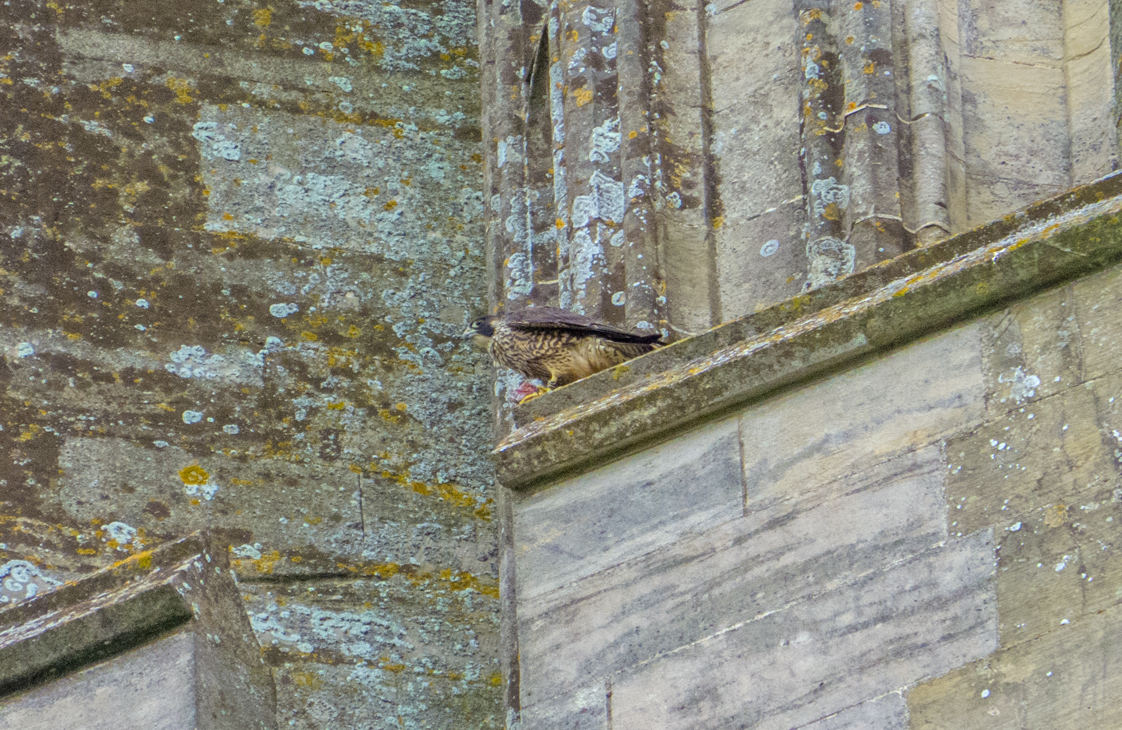


However…. so taken was I again by the view from the South Downs ridge as we drove back along it on the way home, that the following Sunday found me setting off before dawn from Colchester, heading back to Sussex armed with paints, pastelles, pencils and various essential accessories. On Google Maps I’d spotted a cafe at the end of the ridge, so I reckoned I could park there and then walk back to the view with the intention of photographing and painting it. What I hadn’t bargained on was the fact that it was a gloriously sunny Sunday and the Whiteways Cafe is a biker-meet. There must already have been more than 50 bikes of all breeds, styles and states of repair in that car park although it was still only 8 a.m. Grabbing a bacon sandwich from the cafe, I sat amidst the bikers contemplating my next move and looking for ‘classic’ (i.e. slow) models that I had once owned – a Honda and a Moto Guzzi. After an unsuccessful search – everything now is sleek, flash and, as I was to discover, very loud – I staggered off up the road, laden with photography and art gear. Meanwhile bikes screamed past in an endless banshee wail, making the most of the beautifully straight road as it runs along the crest of the Downs. Having arrived at the view which had dragged me half way across the country yet again…

…I was disconcerted to find that there was the narrowest of roadside verges beyond which there was a steep drop of some seven or eight feet down the road-bank into the field below. The bank was smothered in a thick tangle of traveller’s joy (Clematis vitalba), bramble (Rubus fruticosus) and nettle (Urtica dioica). Carving out something of a precarious perch for myself within this undergrowth – indeed only held in place on the bank by this tangle – there was no denying that the view was glorious, both in front and behind:


Unfortunately not only was I balanced like a tightrope walker, I was also inches from the road along which seemingly hundreds of bikes were thundering and screaming past, all day. It felt like trying to sit and paint serene landscapes while sitting in the middle of a Formula 1 race. Soothing and lyrical it was not.
My first attempt at capturing this landscape turned to dust, quite literally, when the pastelles I was using (a HomeBargains special) just crumbled across the paper resulting in something less than light and lyrical:

So I turned to my paintbox and a new sheet of paper. Word of advice: Never under-estimate the potential impact of a gift given to a seemingly un-enthusiastic teenager. This painting tin was given to me on my 14th birthday. It’s still my favourite and still being used almost 50 years later:

Now balancing paints, water, brushes, drawing board and the occasional sandwich while perched precariously above a seven-foot drop was not as conducive to great art as one might wish, and trying to shut out the roaring banshee of the bikes hurtling past a mere three inches from my left ear was proving increasingly difficult:


I suppose the result was inevitable. A cafe racer who had been up and down a few times came roaring back, apparently this time aiming to pass as close to my little camping chair as he possibly could. The noise, and the shock, resulted in me doing a nose-dive straight down the bank in a tangle of traveller’s joy, paints, nettles, painting water, brushes, brambles, startled artists and folding camping chair. I still bear the scars on my shin, but fortunately the tangle of vegetation acted as something of a safety-net – albeit a prickly and stinging net. Having disentangled myself and now being down in the field, I thought I might as well make the best of a bad job and take a panorama photo from the edge of the maize stand, looking over a rather beautiful poppy field:

Walking round and up onto the verge again, I was able to collect my scattered thoughts and brushes and paints, finally completing the sketch an hour or so later:
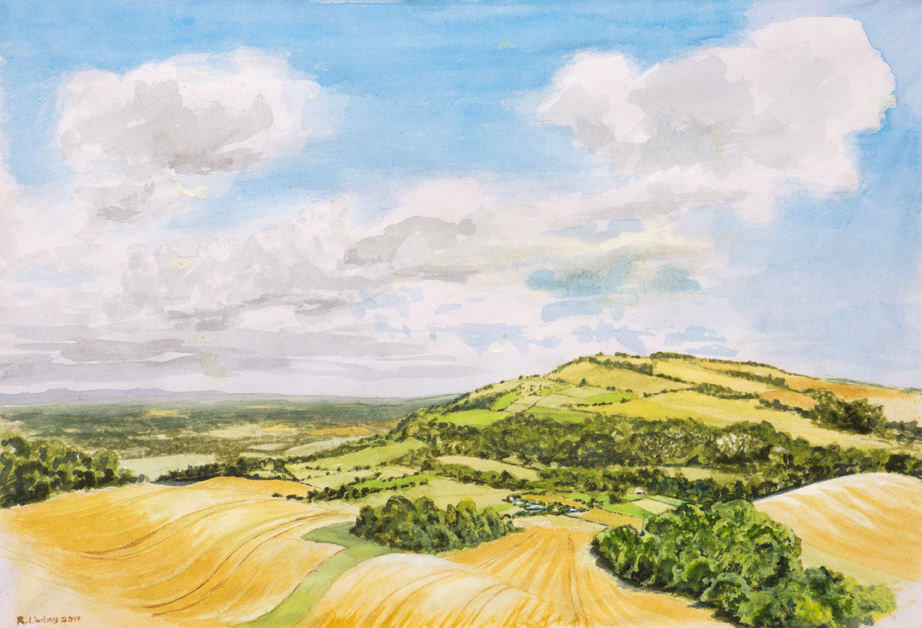
The following weekend we decided to go back to Chichester again – you can tell that we were all rather taken with it – and we decided to visit the nearby Tangmere Military Aviation Museum, based on the old RAF Tangmere Sector Station – one of the key stations during the Battle of Britain:

It proved to be one of the best, most involving, and in some ways most moving, aviation museum I’ve ever visited. Daughter enjoyed flying in a couple of simulators then fiddling with all the knobs, dials and levers on various radio sets, as well as having a go at morse code, while I discovered a Link Trainer – a flight simulator from the war and immediate post-war, used to train pilots in blind flying and navigation. The ‘crab’ thing on the left tracks your flight progress across a chart on the chart table. I was in charge of the link trainer in our CCF at school, so it was delightful to see one in full working order again:

I also had the opportunity to sit once more in the cockpit of a Chipmunk trainer (minus wings). I had last flown in one of these lovely little planes nearly 50 years ago at RAF Woodvale – oddly enough, the same type of aircraft and the same RAF station that is the very final entry in my father’s RAF Pilot Log Book at the end of the war…

By far the most moving things I found, however, were two framed pictures. They contain the collected signatures of all RAF pilots who flew in the Battle of Britain. What shocked – and moved – me was just how few there were, yet they changed the course of the Second World War:


Afterwards, heading into Chichester, we had a very pleasant afternoon, and I discovered that the city’s patron saint is St. Richard, who looks pretty severe in his statue but he not only argued with the king on behalf of the poor of Sussex, he is also reputed to have penned the prayer that ends with some of the most famous and beautiful lines of poetry in the English prayer book:
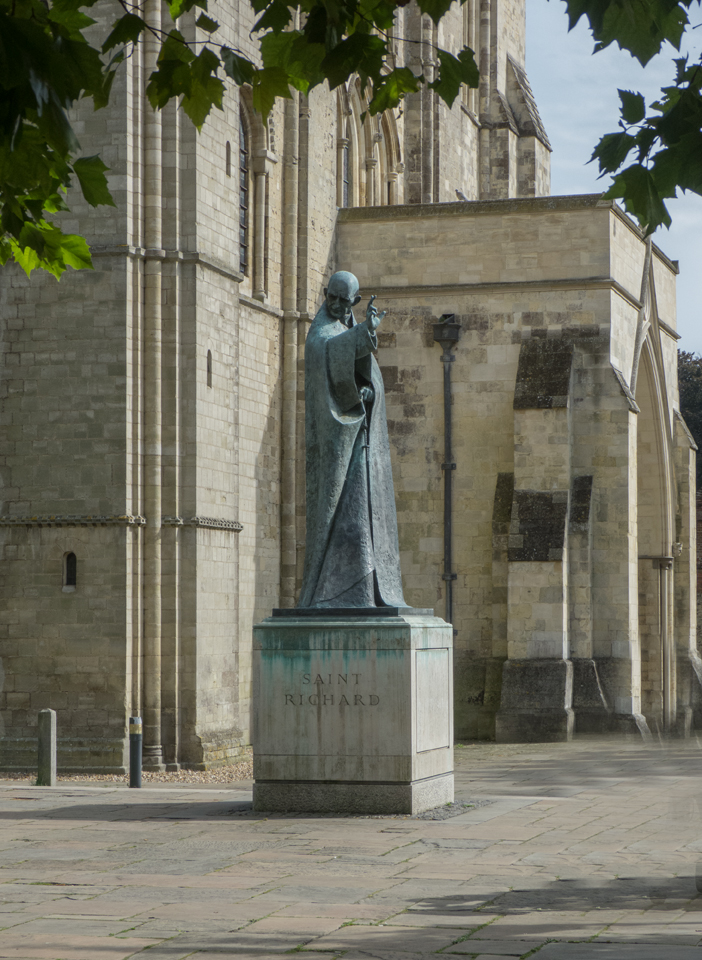


We ended our visit by going into the cathedral just as the choir practice was beginning, so we sat for a while as the glorious singing soared up into the cathedral tower to mingle with the faint cries of the peregrines outside:

Just a week later, back in Colchester, daughter was taking part in a film-making school which was filming in the shadow of ‘Jumbo‘ – the great Victorian water tower which sits right on the crown of the hill on which Colchester is built. When we arrived to collect daughter, the film-school people casually mentioned that filming had been somewhat interrupted by a horde of birders looking at a peregrine on Jumbo…. More peregrines..? Surely not… Then sure enough a white, not brown (as it would have been had it been a kestrel), shape appeared on a ledge high up on Jumbo. Zooming in on this white blob with the new (well, second-hand) Lumix FZ1000 I had bought 1 hour earlier to replace my poor battered, faithful but now-cranky Lumix FZ150, the very first photos in this new camera were indeed of Colchester’s own peregrine…




So now the summer adventures are over – a summer full of aerial and aviation surprises.
Thoughts are already turning to the Minories Christmas Market and the Minories and FirstSite Christmas Makers Market…. Look out for announcements soon about cards printed from my artworks and photography… 🙂
Chichester – planes, predators and paintings : Part 1
A few days down in Sussex staying in Chichester to celebrate a significant family birthday produced a richness of experiences far beyond what was anticipated and ultimately resulted in two further return trips – each just day-trips, it was that good…
The journey down from Colchester took us along a glorious viewpoint across the South Downs and past the entrance to Arundel Castle, but as I was driving these were just brief glimpses. Here, however, is the view I merely glimpsed on this occasion:

Like Colchester, Chichester has its settled origins dating from Roman times (Colchester = Camulodunum; Chichester = Noviomagus Reginorum) although both were significant centres for pre-Roman British tribes. From the 11th Century onwards the heart of Chichester was the cathedral. There’s a lovely walk around part of the remaining city walls, and an information board gives a real sense of what the early city must have looked like (all credit to the un-named artist):

The cathedral is a beautifully proportioned building:

It nevertheless has a number of unexpected features. Firstly, it is one of the few cathedrals in the country to have a bell tower standing separate from the rest of the cathedral. It also has a complete and serenely cooling cloister:

But it has other surprises too, as I was later to discover…
As the weather was so glorious we opted to head for the beach at West Wittering, as recommended by the very helpful agent of the cottage we were renting. Having left the extended family happily splashing about in the shallows of the beach, I headed off inland to investigate an interesting-looking wetland – clearly a remnant dune-slack area. Much of the dune-slack had now been converted to wheat field:

The wheat was just approaching the point where it begins to turn head-down and ripen:


Amidst the wheat but particularly along the fringes of the field there was an array of modern wheat-field ‘weeds’, including oats, common mallow (Malva sylvestris) and field bindweed (Convolvulus arvensis):



There were also many flowering heads of cow parsley (Anthriscus sylvestris) which acted as landing platforms for a variety of insects:


These included the common red soldier beetle (Rhagonycha fulva), probably the marmalade hover fly (Episyrphus balteatus) and possibly a gall wasp:



Then my attention was caught by something rather larger emerging from the fenced-off wetland area:

At first I wasn’t sure, but then as it made its way round the far edge of the field I caught a view which suggested I was watching a marsh harrier (Circus aeruginosus), a species I’d last seen more than 15 years ago while moored on Merlin close to the reedbeds of Hickling Broad:

This was exciting, but then my ears caught a faint but unmistakable sound – a Merlin engine. Looking across the wheat field I could see a dot in the sky, heading towards the coast:

Its course brought it somewhat closer and, as it banked, there was the unmistakable elliptical wing shape of a Spitfire (the iconic elliptical wing designed, not by R J Mitchell as many believe, but by his associate Beverley Shenstone):


A beautiful aircraft, a gorgeous sound, and all most unexpected, coming directly on the heels (or tail feathers) of the marsh harrier.
Rejoining the family on the coast, we then moved on to the excellent Billy’s on the Beach at Bracklesham Bay, where we sat outside enjoying the evening sunlight while we tucked into mountains of seafood. Only to be interrupted by the sound of the Merlin engine again, which meant that food was abandoned as I grabbed my camera. We were then treated to the most amazing aerial display over the sea while we sat back with a grandstand view:



Then as it flew low over the beach past us, it became obvious that this was a two-seater Spitfire, with someone in the passenger seat having the time of their life:

In a way, and to some extent, I knew what they were experiencing because back in May my lovely sister had arranged a visit to the RAF Museum at Hendon, and there I was treated to the opportunity of sitting in the cockpit of a Spitfire once the personal plane of Air Vice-Marshall ‘Billy’ Elliott:

I’d been somewhat doubtful about the added experience of actually sitting in a Spitfire compared to simply enjoying its beautiful shape from afar, but I was very surprised to find that it was quite a moving experience. It brought home just how each Battle of Britain pilot fought alone, within the space of their own cockpit, and with such basic (though well-designed) tools. Should you find yourself watching the film Dunkirk, think of this as you watch Tom Hardy juggling fuel, ammunition, distance from home, duty to those below, as well as facing hostile and well-armed enemy aircraft:


 Purists will note that I’m holding the spade joystick with completely the wrong hand. When held in the right hand at the top of the grip (the left hand being constantly on the throttle lever on the left wall of the cockpit), the brass firing ring fits snugly under one’s thumb.
Purists will note that I’m holding the spade joystick with completely the wrong hand. When held in the right hand at the top of the grip (the left hand being constantly on the throttle lever on the left wall of the cockpit), the brass firing ring fits snugly under one’s thumb.


In contrast to that of Tom Hardy and the original pilots, my experience was, to some extent, what the passenger in the Spitfire flying over Bracklesham Beach was seeing that evening… provided, that is, their eyes were not still watering from having paid almost £2,500 for the flight, as we discovered later…! Apparently this is the regular flying area for a pair of 2-seater Spitfires based nearby, and despite the price, the waiting list to fly as a passenger is longer than the Great North Road…
Afterwards, replete from Billy’s and having watched the Spitfire and its happy passenger heading off to the airfield in the evening light, we were treated to exhibitions of flying without effort by a flock of black headed gulls (Croicocephalus ridibundus) which settled on the shingle storm-berm of the beach:







Arriving back in Chichester, I was sitting in our bedroom gazing out from the open window towards the cathedral and I realised that the high-pitched whistling scream which I’d been hearing regularly during our stay was not, in fact, coming from a baby pigeon under our eaves but was in fact coming from the direction of the cathedral, and was therefore very much louder than I’d originally realised. A quick dash out in the fading light to the cathedral resulted in a brief glimpse of something potentially rather exciting:

Of that, and more – including chipmunks, motorbikes, predators and painting accidents – look out for the next blog….



